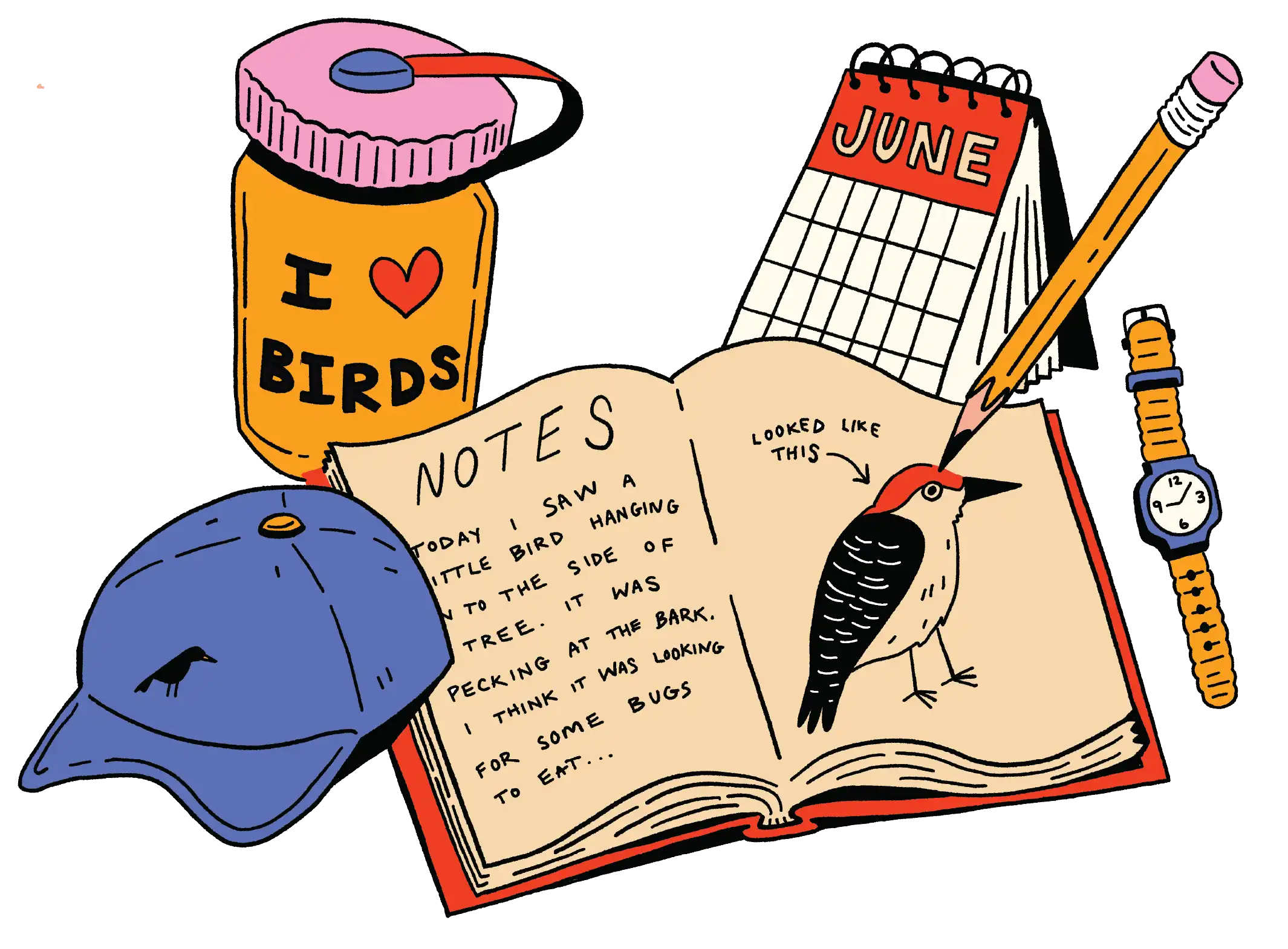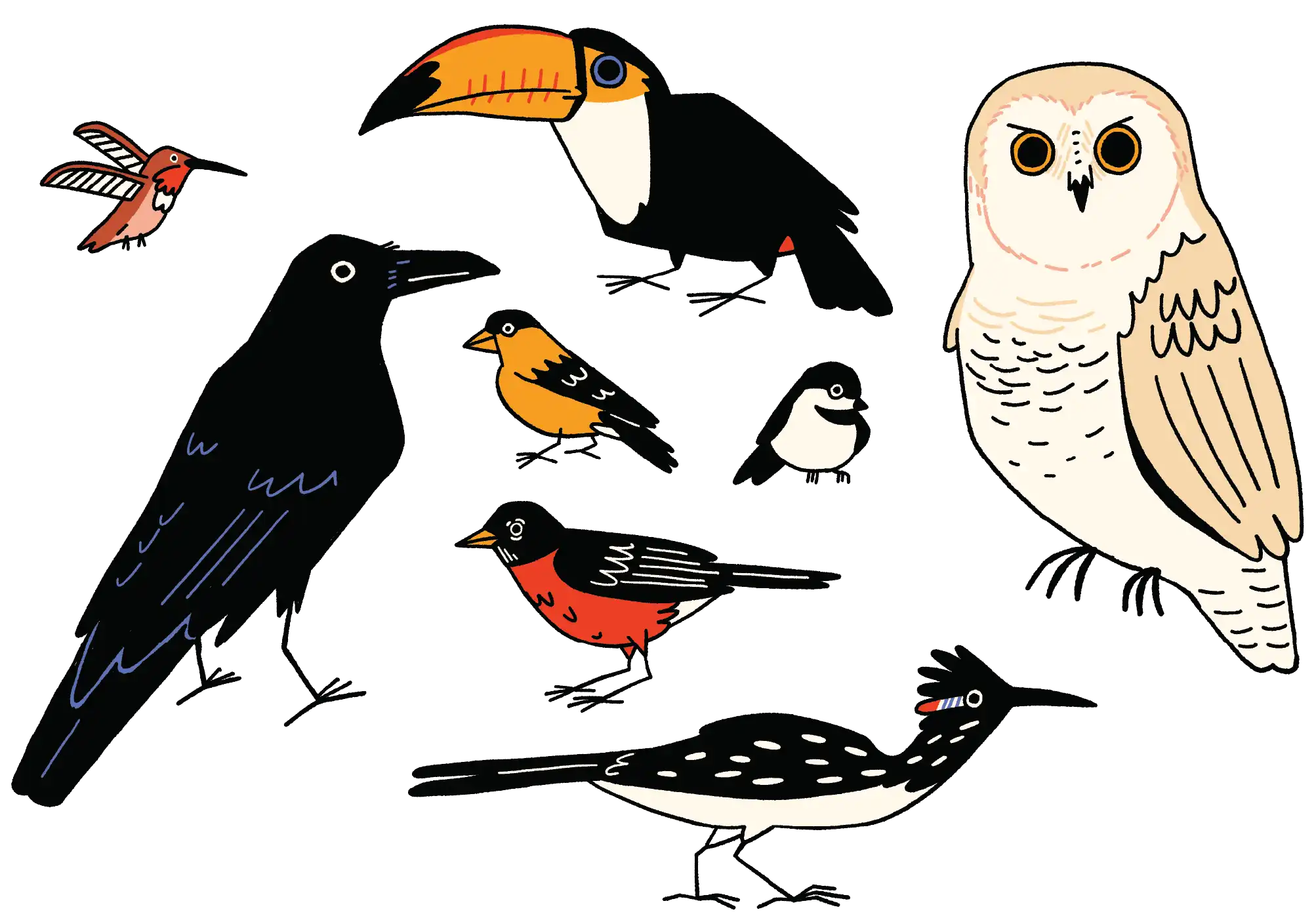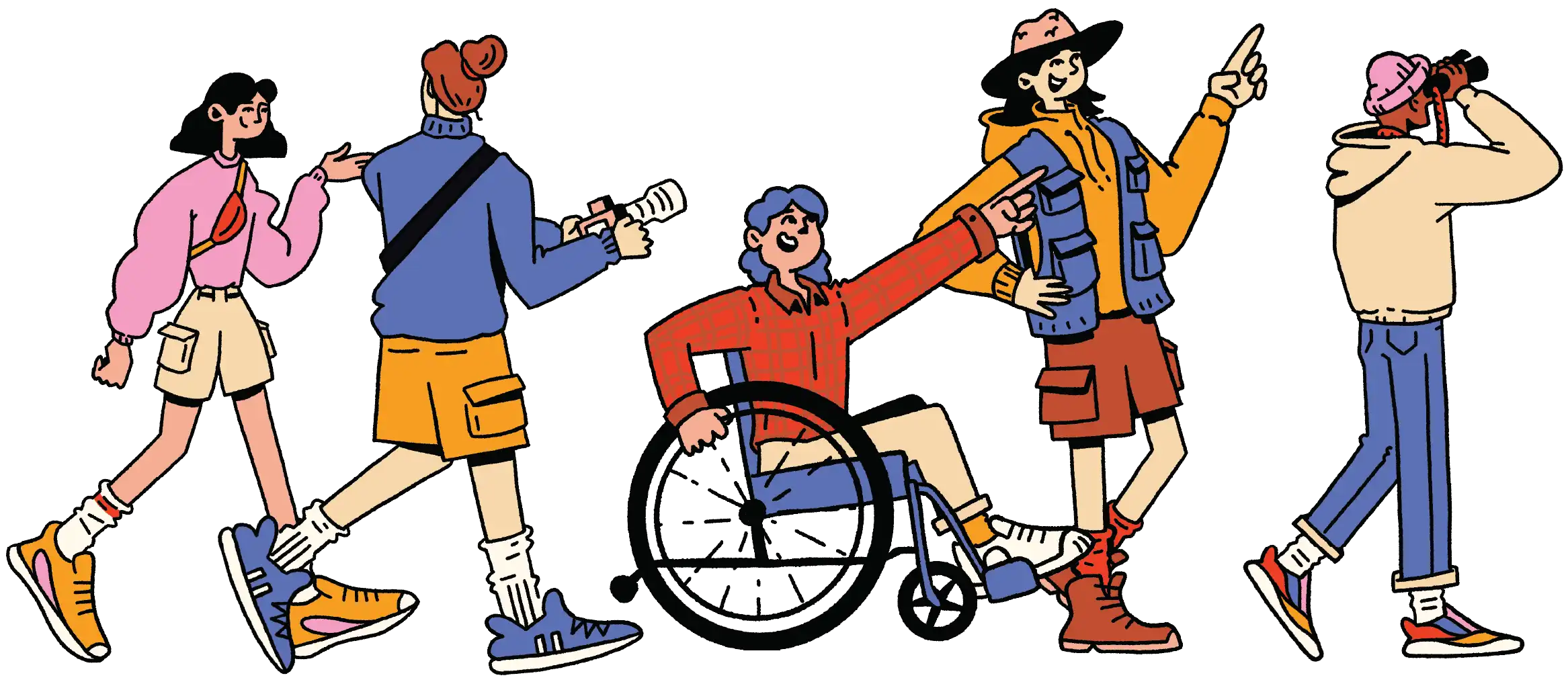
The Ultimate Beginner’s Guide to Birding
Illustrated by Jeffrey Burke
What is Birding?
For us, birding is the act of experiencing and enjoying wild birds. And like all forms of enjoyment, there’s no set way to do it. We love the term “birding” because it communicates the open-ended nature of the activity, and accommodates any kind of experience—including visual ones. Birdwatching is also a common term, and many use it interchangeably.
There are no prerequisites. One of our favorite sentiments comes from Birdability: Birding is for everybody and every body—regardless of disability or other health concerns.
This article is for anyone who is curious about birds and wants to learn more about them. In it, we share our Bird Collective birding philosophy, experiences, tips, references, and ideas on how to build your own relationship with birds.

Why Go Birding?
Birds are incredible creatures. And even in their wildness, they are very accessible to us—you can find them right outside your window, as you step outdoors, as you look up in the sky or across the land- or cityscape. You can even bird from home. Have you ever heard the whistling sound of a mourning dove in flight, the honking of Canada geese, the calls of chimney swifts at dusk, or the late-night song of a mockingbird or whip-poor-will? Birds are all around us. And you can really bird any place and any time.
Of course, some times are better than others. And birding will also attune you to birds’ life cycles, the changing seasons, and the ecologies we’re a part of and significantly impact. There’s a huge variety of birds, and because most of them migrate, it’s possible to see tens or maybe even hundreds of species throughout the year, without traveling far from home. The arrival and departure of certain birds cue us into the changing seasons, and their migrations connect us to faraway places and distant continents.
Perhaps most importantly for us, it’s meaningful and rewarding to care for lives different from our own. Being in relation with birds helps develop respect and compassion for them and, hopefully, all forms of life. It also helps us recognize how deeply our actions impact them. We can make space for birds, we can live together with them, we can learn how to make their migrations safer, and we can be more intentional about our choices when we understand their impacts on others.
Getting Started
Taking note
Start by taking note of birds as you encounter them. You don’t even have to change the events of your daily routine—just your level of awareness. What do they look like? What do they sound like? Where do you find them? What are they doing? What time of the day is it, and what season?
Try comparing and identifying birds
First, get familiar with your local birds. If you live in a city in North America, then pigeons, house sparrows, and starlings are very common, as they’ve adapted to urban environments. If you live in a suburban or more rural area, you might frequently come across crows, doves, sparrows, or jays. Whatever the birds, get to know them well. They can then become helpful reference or “yardstick” birds for you to compare with new species you encounter.
Comparing birds is a great way to hone your skills of differentiation, and you can do this even without a field guide or external reference source.
Seek birds out in different habitats and locations
Each bird species has evolved over time to certain physical and environmental conditions, such as climate and terrain, as well as to other species in a web of interactions. Thus, seeking out a variety of habitats—such as woodlands, grasslands, wetlands, deserts, etc.—will expand the range of bird species you encounter. You can always start by exploring your yard or street. Then, try heading to a local park, green space, or wetland.
If you’d like to plan a bit more, try exploring birding hotspots near you on eBird, an online database for world-wide bird sightings. The website is extensive, and you can find an interactive map here. For those who want to check the accessibility features of a trail or birding area, the Birdability Map, created by the National Audubon Society in collaboration with Birdability, is a helpful interactive resource.
Seek birds out at different times of day or seasons of the year
Different birds are active at different times of the day. Most birds are diurnal, meaning that they sleep at night and are awake during the day. So generally, morning–especially early morning–is a time when these birds are actively foraging, and thus easier to observe through sight and sound. There are also nocturnal birds, like owls and nightjars, that are awake at night and sleep during the day. Though these birds are hard to see in the cover darkness, they can often be heard, and dawn and dusk are good times to catch glimpses of them. For raptor lovers, mid-morning through mid-afternoon can be best to view birds of prey during migration, as these birds frequently use thermals, or upward currents of warm air, to soar long distances. Thermals are heated by the sun, generally starting around 8 am, and are strongest during midday.
This leads to the point that the question of when to watch birds relies greatly on the time of year. Birds’ life cycles follow the seasons. Here in North America, about 75% of bird species migrate, traveling hundreds or even thousands of miles twice a year to find the best habitat and food sources for survival. Migrating birds typically fly north in the spring to breed in areas with long stretches of daylight and abundant food sources, then migrate south in the fall to winter in warmer climes. Thus, most people will see the most variety and density of birds during the spring and fall, as hundreds of species are on the move. And, because it takes enormous amounts of energy to fly these distances, birds spend longer periods of time feeding. Most birds migrate at night, and you can track them by listening for their flight calls on a quiet night, or by fixing your binoculars or a telescope on the moon when it’s full, and watching them pass. These birds land at dawn to feed, so early mornings are spectacular times to observe birds during the spring and fall migrations.

Basic Equipment Needed
You don’t need any specialized gear to bird. But if you want to enhance your ability to find and study birds, and/or if you want to learn more about birds and how to identify them, here’s our short list.
Binoculars
What are the best binoculars for birding? First, you’ll want to consider several factors: magnification, the brightness of the image, the field of view, the speed of focusing using the focus wheel, durability, fit, and comfort. Look for a pair with adjustable eye cups so you can be sure your bins are the right distance from your eyes to give you an unrestricted view (no dark crescents or shadowing around the edges).
Binoculars are typically specified with two numbers, such as 8x42. The first number is the magnification power; in this case, they will magnify the image 8 times that of the naked eye. The second is the diameter of the objective lens, which is the lens on the far side of the barrel from where the eye goes. The wider the diameter, the more light the lens will let in, making the picture brighter and with better color rendering.
Many birders like to use magnification 8, though magnification 10 is good for hawk watching or observing birds at a farther distance. The higher the magnification typically makes the field of view smaller, though, making it harder to capture a fast-moving bird. Also, magnification amplifies hand movement, so it’s harder to keep the view of higher-magnified binoculars steady.
For fit and comfort, much of this is personal preference. Most birders use binoculars with an objective lens diameter of either 42, which is considered full-sized, or 32, which is considered mid-sized. The 42s will let in more light, so consider if you plan on birding in low light conditions, such as dawn or dusk. The drawback is that they are bigger and heavier. If you don’t want to think twice about lugging a pair of binoculars around with you all day, you might want to consider 32s, which are lighter and smaller—sometimes significantly so. Of course, there are various ways to carry binoculars, and a harness, which distributes the weight to both shoulders, can alleviate fatigue.
You should always try out a pair of binoculars before purchasing, to be sure they fit you well and you’re happy with the image, focusing, weight, fit and hand-feel. And because price impacts quality and durability, we suggest you invest in the best pair you can afford. They will be your constant companion on birding adventures, and may last you a lifetime.
Field Guides
Acquiring a field guide is often the first step to learning how to identify birds, especially if you bird mostly on your own. We love books, and having a beautiful one handy by your window or coffee table makes getting to know your area’s birds an easy and enjoyable break from any routine. If you plan to take your field guide with you on your birding outings, make sure you choose one that’s small and light enough. For this reason, many field guides are broken down by geography, such as the Sibley Field Guide to Birds of Eastern North America, and the Sibley Field Guide to Birds of Western North America.
Bird field guides are typically either illustrated with paintings or drawings, or use photographs (though oftentimes more specialized guides will use both). Both are helpful, and personal preference will guide which kind you use when starting. We use both. Photographs capture a specific individual, in focused, realistic detail. With illustrations, an artist renders an idea of the species. For us, this sometimes helps communicate an impression that is easier to map to different individuals seen in the field, rather than matching a photo of a unique individual to another one that’s usually seen with less clarity and detail.
Digital Field Guides, Apps and Tools
Technology has changed birding in many ways, and this includes formats for field guides. When Roger Tory Peterson created his first portable field guide, it changed people’s ability to identify birds in the field, because they had a portable reference to consult when needed. Similarly, birding smartphone apps have made birding more accessible. Here are a few digital tools we recommend starting with:
eBird
eBird is an online database created by the Cornell Lab of Ornithology to document bird observations across the world. It’s an incredible resource to explore locations and what birds have been observed there, and also a powerful tool for science. By creating an account and logging your own bird observations, you not only have a way to track your own birding statistics in one place, you contribute it as data in an important citizen science project. Researchers across the world use the information in eBird as a way to understand bird populations, distributions, and trends. eBird can be used via its website or via its smartphone app.
Merlin Bird ID
This smartphone app, created by the Cornell Lab of Ornithology, helps identify birds anywhere in the world. By asking you simple questions about the bird and using your location, Merlin gives a list of possible matches. It also has a great sound ID feature that listens to the birds around you and shows real-time suggestions for who’s singing. You can download it here.
Notebooks
A good notebook is an excellent tool to record and remember your sightings, or to sketch and journal about your experience. The act of writing or drawing reinforces learning, and the creative activity can enhance your birding hobby.
Keeping a bird list
Keep records of your bird outings and sightings in either a portable notebook you bring into the field, or one you keep at home to jot notes in afterwards. Try including information like date, time of day, duration, location, weather, distance traveled, number of people in the party, and of course the bird species found (seen or heard), with a count for each. Also try adding details such as impressions, behavior, field markings, or the age and sex of a bird (if you can tell). If you aren’t sure what the bird is—try noting your thoughts, or what’s confusing. Later, if you share your findings with another birder, this information may help them identify the bird.
For a notebook with some serious heft, we recommend the Sibley Birder’s Life List & Field Diary. Meant to last a lifetime, it includes a checklist of all known North American birds and space for personal notes.
Journaling & Sketching
We love this bird passport and field journal—it’s small, light and flexible, a format that’s great for field studies. Each spread opens flat and has specific data fields to fill in, as well as a nice clear page for free sketching. A bit of structure can sometimes prompt creativity!

Identifying Birds
Encounters with birds are oftentimes fleeting. You may only catch a glimpse of a bird or hear it for a moment. But that may be all you need to identify it! How? First, by noting your impression in as much detail as possible.
When observing a bird visually, pay attention to its physical characteristics, which are called field marks. Some things are relatively easy to see with the naked eye, such as the overall size and shape of the bird, or the color tone (darkish, lightish). Other field marks, like finer colors or patterning, are hard to see without magnification. That’s why a good pair of binoculars will drastically enhance your ability to observe and identify birds. And finally, there are field marks that are probably not observable at all unless you can touch the bird—something we never recommend with live birds unless you are a bird researcher or working with one, or if you’re aiding a bird in distress (in which case you’re not checking their undertail coverts, anyways!). Here are some key questions:
What does the bird look like?
Size:
How big is the bird? Try comparing it to a bird or two you are familiar with, perhaps a pigeon, robin, or house sparrow. For example, you might note that it is larger than a house sparrow, but smaller than a pigeon. If there are other birds near it, compare their sizes. And get to know your local “yardstick” bird—that bird you see a lot and can reliably call to mind for comparison.
Shape of the overall body:
What shape is the bird’s body overall? Is it roundish, elongated, blocky? Top- or bottom-heavy? Does a particular body part draw attention, such as the legs, bill, or neck? For perched birds, what is its posture? Is it more upright or more horizontal?
Shape of the wings in flight:
Consider the overall wing proportions—are they long and thin? Short and wide? What about their profile shape—are there individual feather tips or slots between feathers visible? Are the wings rounded? Pointed?
Shape of the bill:
Is it long and thick like a Great Blue Heron’s? Or short and stout, like a Rose-breasted Grosbeak’s? Is it hooked, like a bird of prey’s? Flat and wide, like a duck’s? Curved, like that of an Ibis? Small and fine, like a warbler’s?
Shape of the tail:
Is it forked, like a Barn Swallow’s? Notched, like an American Goldfinch’s? Rounded, like a Blue Jay’s? Pointed, like a Mourning Dove’s? Square-tipped, like a Sharp-shinned Hawk’s?
Other field marks to note:
- Color(s) and overall contrast of a bird
- Wing bars
- Eye ring (ring around the eye), eye line (line through the eye), eye brow (line above the eye), eye arcs or crescents, spectacles
- Other facial patterning: color on crown, cheek, nape, throat
- Tail patterning
- Chest/body patterning: spotting, fine or coarse streaks (vertical or running along length of body), banding (horizontal or running across body), necklace or breast band
What sounds does the bird make?
Explore and consider the sounds a bird makes.
- For vocalizations, is it a long or short vocalization? A song is usually considered a longer vocalization with multiple notes or parts, whereas a call is a short vocalization of one or two notes. Birds vocalize to communicate, and a song might be used to attract a mate or defend a territory. Oftentimes, a bird will perch while singing, sometimes in a prominent place. A call might be sounded in flight or when foraging. When listening to a vocalization, consider how many parts it has, and its overall qualities. Is it rising or falling? Is it buzzy? Clear? What is its speed?
- Some birds’ wings make sounds as they fly, like a mourning dove or a woodcock.
- Woodpeckers drum with their bills not only to forage but to communicate.
Location: Where do you find the bird?
Where do you find a bird? What habitat? Where is it in relation to the ground? Is it on the ground, in the understory, or in tree canopy?
Where do you find it in relation to water? Is it in water, on the shore, and what kind of water/wetland (salt, brackish, fresh)?
Behavior: What is the bird doing?
- Feeding behavior - How does it forage or hunt? What does it eat? A bird eating seeds might forage on the ground, on grasses and flowers, or in a tree. Seed-eaters also frequent bird feeders. Birds that eat insects might hover in the air, flycatching, or might creep along a trunk, probing with its bill. Wading birds oftentimes stalk the shore silently, barely moving until they dart their head down to snap up a lizard or fish.
- How does it move? Consider flight style and patterns. If it's on the ground, does it hop or walk?
- Is it social or solitary?

Birding Ethics and Etiquette
When birding or photographing birds, it’s easy to be focused only on one’s own experience. But our behavior has a huge effect on others—birds and people alike, as well as habitats and ecosystems. Birding etiquette may sound stodgy, but it’s incredibly important, and central to our birding philosophy.
Here are a few resorces on birding etiquettee:
Birding Etiquette and How to Be an Ethical Birder
The American Birding Association (ABA) Code of Birding Ethics
Birding mindfully is not just about yourself, but about consideration for everything and everyone around you. Also, remember that your actions shape others’ perceptions of birders, so do your best to be a respectful and positive ambassador of birding culture.
Joining a Birding Community
Birding is a culture, and it’s evolving. One of the most rewarding aspects of birding for us is the community! We met through birding in New York City—and through volunteering for the Brooklyn Bird Club. When we started Bird Collective in 2019, we wanted to raise awareness about wild birds and connect bird lovers in an inclusive, welcoming and creative community. For us, caring for birds is also about caring for each other and our shared planet. That’s why we partner with conservation groups and give back through donations and volunteer work.
So how do you find or build a birding community?
- Go out with a friend or two. Birding is a great hobby to share.
- Look for local birding clubs or organizations. Many offer free or low-fee walks. The Feminist Bird Club is an inclusive community, and has chapters across the US. The National Audubon Society also has an extensive network of local chapters. You can search for one near you here.
- Volunteer with a birding or bird conservation organization. It’s a great way to give back, learn more, and become part of a like-minded community.
You can also volunteer by participating in citizen science events, such as
- The annual Christmas Bird Count (December)
- The annual Great Backyard Bird Count (February)
- Breeding Bird Atlas
- Building Collision Monitoring - Birds can't see glass as an obstacle, and so many die in building collisions, especially during migration. If you live in an urban area, there may be a building collision monitoring program. You can learn more at NYC Bird Alliance, Chicago Bird Collision Monitors, Birds Connect Seattle, Bird Safe Philly.

Our Conclusion
Birding is an accessible hobby with many great benefits, including physical and mental health. Exploring the outdoors or even looking out the window helps us get out of our heads and connect with nature. Paying close attention to our immediate environments is sensorially and mentally stimulating, and a wonderful exercise in being present. Noticing wild birds and observing them through sight and/or sound builds an appreciation for nature and other living things. It can also teach us patience and compassion. Recognizing and identifying birds is thrilling and satisfying. And learning more about them—their behaviors, life cycles, biology and ecology—can become a lifelong educational journey.
So what are you waiting for? Let's go birding!
















